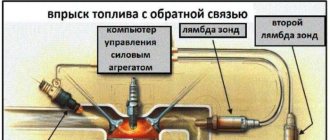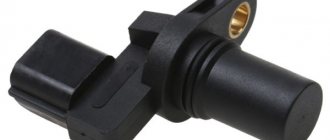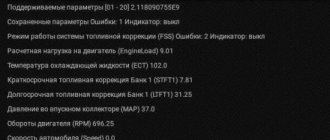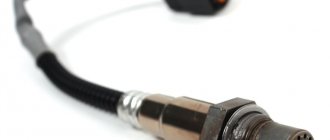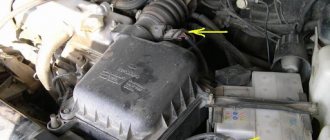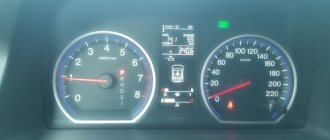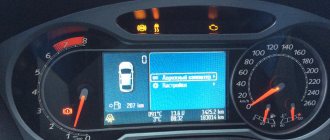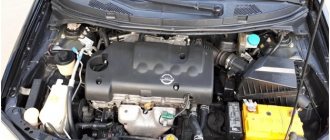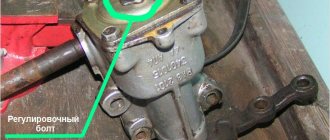Are you trying to get rid of the P0420 error code? Then this article is for you. The P0420 fault can be difficult to diagnose. You think you have fixed the error, but after 100 km the Check Engine light comes on again.
This code is triggered when the engine control module detects a faulty catalytic converter. It uses one oxygen sensor at the front of the exhaust manifold - before the catalyst, and another oxygen sensor - after the catalytic converter to measure the efficiency of the catalyst.
In this article, you will learn everything you need to know about the P0420 code to fix it once and for all.
What does code P0420 mean?
P0420 is triggered in the Electronic Control Unit (ECU) when there is a problem with the performance of the catalytic converter. The controller uses two oxygen sensors - one before and one after the catalyst to measure its efficiency. The error occurs if the converter or oxygen sensor malfunctions, which begins to transmit incorrect data.
We receive many messages asking about the P0420 code. It keeps coming back after several repairs and you just end up spending more and more money on auto repair work. This trouble code may confuse you because there is a lot of misinformation about it.
Catalytic converter
- The front O2 sensor measures the air-fuel mixture. It tells the control unit if the engine is running rich or lean.
- The rear O2 sensor is the diagnostic oxygen sensor for this error code.
If the rear oxygen sensor receives incorrect values, a P0420 fault will be stored in the ECU. This could be due to a faulty catalytic converter or one of the O2 sensors failing. There may also be many other problems with the engine that are destroying the catalytic converter, and if you install a new one, it may be damaged again.
The oxygen sensor is also called a lambda probe.
Many people think that a lean or rich mixture can cause this error code. Yes, it is possible, but not in the way you think. A rich or lean mixture can damage the catalytic converter and when it is damaged/full of fuel it will be low in efficiency and the rear oxygen sensor will see this and trigger a P0420 code.
Under what conditions is error P0420 diagnosed?
In order for the electronic control unit to diagnose error P0420 during the system check, it must analyze information from the oxygen sensors. Over a certain period of time, information from the first and second oxygen sensors is analyzed. If, as a result of the test, it turns out that the duration of the voltage signal is not within the thresholds specified in the ECU, this is a clear sign that there are problems with the catalyst.
Please note: In order for the Check Engine light to come on, the threshold value of the difference between the amplitudes of the first and second sensors must be more than 0.7 per minute. Moreover, it should last longer than 100 seconds with a significant load on the engine (rpm from 1700). Another important characteristic for the occurrence of error P0420 is the temperature of the catalyst. It should be above 500 degrees Celsius (may vary depending on the ECU firmware).
It is worth noting that two oxygen sensors are installed on all cars of Euro 3 standard and higher. They are necessary to diagnose problems with the release of hydrocarbons into the environment above specified standards. During engine operation, the electronic control unit constantly receives information from the first and second oxygen sensors, and, based on the information received, determines the correct operation of the exhaust system and the catalyst in particular. When the exhaust system is operating properly, the oxygen sensor output signal switches gradually between two states: rich and lean. If switching occurs more often than necessary, this indicates a problem in the catalytic converter system.
Symptoms of the error
You probably won't have any symptoms other than the P0420 check engine light coming on. You may experience other engine problems that damage your catalytic converter.
This could include a rough (“rough”) idle, acceleration problems, misfires, or harsh gear changes. Always fix these problems first.
- The Check Engine light is on.
- Misfires.
- Rich mixture.
- Poor mixture.
- Engine oil is burning/gray-blue smoke coming from the exhaust pipe.
- Slow acceleration.
Error code P0420 came on, what could have gone wrong?
Options:
- The catalyst has melted, burned out, or simply exhausted its resource . Most often, error P0420 is associated precisely with the fact that the catalyst has burned out or is clogged. In this case, the catalyst is most often removed from the exhaust system due to the fact that it is simply damaged. You can replace it with a flame arrester, resonator, stronger or a new catalytic converter. We have a huge selection of different products and you will definitely find the option that suits you! It is extremely important to undergo diagnostics to make sure that replacement is necessary, and if it is required, the specialists of the Catalyst Replacement will help you select the optimal replacement element.
- Mechanical damage to the exhaust system . For example, a cracked manifold. Everyone who owns a car sooner or later gets into minor accidents, runs over bumps, curbs, speed bumps, as a result of which, of course, the exhaust system suffers, pipes, catalysts become wrinkled, corrugations break, etc. It often happens that the corrugation can burn out due to high temperatures, or the manifold can crack due to a clogged catalyst, for this reason the P0420 error could occur. With any such mechanical damage, you need to go to a service center so they can help you solve the problem. Some parts of the exhaust system can simply be straightened, which is called “working with the tin”, some have to be replaced, for example catalysts, since the ceramic matrix breaks due to mechanical stress.
- Muffler corrugation malfunction . Damage to any element of the exhaust system can lead to breakdown of the catalyst. We conduct a full diagnostic of the entire system to determine the root cause of the breakdown and eliminate it.
- A glitch in the “lambda sensor” of the electronics , or if the catalyst has already been removed, then it’s a scam. It often happens that you have an error, but in the end the problem turns out not to be the catalyst at all. Quite often, lambda probes, emulators, sensors and other devices that are designed to index the proper operation of the device fail. You can only understand where your problem is in the service department, since this requires certain equipment and knowledge. We recommend that you come to us to diagnose error P0420; we do it for free. We quickly find out what your problem is and solve the problem.
- Electrical fault. Often an electrical fault leads to a catalytic converter failure. For example, it is known that many modern cars are produced in China, where over time cars have become better assembled, but various mistakes are still made, including wiring problems; people often come to us with this problem. But it is possible that the catalyst error is on not because it is clogged, but simply because the electronic control unit does not correctly perceive the signal from the lambda sensor, the switching was carried out incorrectly somewhere, etc. Such nuances cannot be determined by eye, so if you want to find out exactly what happened, go to the service center! Anything can malfunction: lambda probe, wiring, snag, etc.
In any case, error P0420 indicates a failure of the catalyst or low efficiency of its operation. You can remove the error and also solve the problem with it only from highly qualified specialists! Many people say that you can clean the catalyst yourself, as well as remove it yourself. Craftsmen are skeptical about this kind of opinion, for the simple reason that it is impossible to correct the error without special equipment, and cutting out the catalyst may not be so easy, because it is often paired with exhaust manifolds and then they need to be removed as well. In general, there is a greater chance of breaking the car than solving the problem normally, and in terms of time, it takes an inexperienced mechanic to remove two catalysts up to 8 hours, if possible at all.
Causes
The most common cause is the catalytic converter. It may simply be old and worn out. But there are many cases where the neutralizer is new, but at the same time it is a non-original part.
Some cheaper catalytic converters may not be efficient enough, and then you will have to buy an original catalytic converter.
Sometimes converters are installed too far back on the exhaust pipe. This will cause it to not get hot enough and cause a P0420 code.
- Damaged catalytic converter (most common cause).
- Non-original catalyst.
- Incorrect installation (placement) of the catalytic converter.
- Front oxygen sensor damaged / wiring fault.
- Rear oxygen sensor damaged / wiring fault.
- Exhaust gas leak.
- Leak on the intake manifold.
- Oil burns (damage to catalyst).
- Rich/lean mixture (damage to catalyst).
- Misfires (damage to catalyst).
- Faulty engine control unit (rare).
Reasons for the error
A P0420 code may mean that one or more of the following problems have occurred:
- Leaded fuel was used where unleaded was required (unlikely).
- Damaged or faulty oxygen (O₂) sensor.
- The oxygen sensor (HO₂S) wiring is damaged or incorrectly connected.
- The engine coolant temperature sensor is not working properly.
- Damaged or leaking exhaust manifold, catalytic converter, muffler, exhaust pipe.
- Faulty or poorly functioning catalytic converter (probably).
- Retarded ignition timing.
- The oxygen sensors at the front and rear of the catalytic converter report very similar readings.
- Leaking fuel injector or high fuel pressure.
- Cylinder misfire.
- Oil pollution.
Trouble-shooting
These are just possible solutions and you should never change parts without proper diagnostics as you could be throwing money away if you are unlucky.
Read the entire article if you want to learn how to properly diagnose this trouble code just like an experienced auto mechanic would. It will take time and may require some skill, but you won't spend $1000 to replace a good catalytic converter.
- Replace the catalytic converter.
- Replace with original catalyst.
- Replace the front oxygen sensor.
- Replace the rear oxygen sensor.
- Repair of faulty electrical wiring.
- Correct oil burning.
- Correct misfire.
- Correct lean/rich mixture.
- Check the data using an OBD2 scanner.
- Replace the engine control unit (rarely).
Error Resolution Table
| Code | Symptoms | Causes | Causes of catalyst damage |
| Error P0420 | Check Engine Misfire Rich mixture Lean mixture Oil burning/blue smoke from exhaust Slow acceleration | Faulty catalyst Front O2 sensor Rear O2 sensor Exhaust leak Oil consumption Misfire/lean mixture destroying catalyst | Misfire Oil consumption Exhaust leaks Intake leaks Rich mixture Lean mixture ECU malfunction |
Catalyst efficiency below acceptable level (Bank 2)
The catalytic converter is designed to destroy harmful pollutants produced during the combustion cycle of a gasoline engine. By using fine platinum and gold meshes to filter exhaust gases, the catalytic converter is able to reduce harmful emissions.
The catalyst has two oxygen sensors. One of them is located at the top (at the exhaust gas inlet) of the catalytic converter, and the second is located at the bottom.
If the upstream oxygen sensor is working properly, its readings should fluctuate depending on engine temperature and load. The readings of the lower oxygen sensor should remain stable (without sudden fluctuations) if it is working properly and there are no problems in the catalyst.
When the upstream and downstream oxygen sensors have similar readings, this indicates that the catalyst is not working properly. If the lower sensor voltage decreases and begins to fluctuate like the upper sensor, indicating that oxygen levels are too high, the powertrain control module (PCM) will set a P0430 (Bank 2) fault.
Causes of P0430?
- Damaged muffler or muffler leak
- Damaged exhaust manifold or leak in the exhaust manifold
- Damaged exhaust pipe or leaky exhaust pipe
- Engine misfires
- Catalyst oil contamination
- Faulty catalytic converter ( most common )
- Faulty engine coolant temperature sensor
- Faulty upper or lower lambda probe
- Damage to the lambda probe wiring or connectors
- "Overflow" fuel injector
- High fuel pressure
- Using the wrong type of fuel (using leaded fuel instead of unleaded fuel)
Symptoms of a faulty catalyst
At the initial stage, there are no noticeable symptoms with this error. The car drives as before, except for the “Check Engine” warning light on the dashboard. After the engine warms up, power may drop. The car may not accelerate beyond 60-90 km. at one o'clock. The exhaust pipe begins to smell like “rotten eggs.”
How is the error diagnosed?
Using an OBD-II scanner, you need to view the voltage of the downstream oxygen sensor with the car running. The voltage produced by the sensor must be stable. A diagram in the form of a “cardiogram” indicates problems with the lower lambda or catalyst. You need to check for any other faults that may be causing P0430 (Bank 2) and update the ECM software. If your car has misfires or problems with the fuel system, you need to fix them first, and only then figure it out further. The downstream oxygen sensor should be inspected for external damage.
Causes of damage to the catalytic converter
There are several causes of catalytic converter damage that can trigger the P0420 code. Here are the most common ones.
- Misfires.
- Oil consumption.
- Leaks at the outlet.
- Inlet leaks.
- Rich mixture.
- Poor mixture.
- Malfunction of the ECM/PCM control unit.
There are many reasons that lead to malfunctioning oxygen sensors or catalytic converters. You should make sure to correct these problems before you replace any part. Otherwise, they may be damaged again. Check the controller DTC memory for any other trouble codes.
Fix them first. Make sure your car is not burning oil by checking the exhaust smoke, blue smoke = oil, white = water, gray/black = rich mixture.
How to Diagnose Code P0420
Here is a guide on how a professional auto mechanic will diagnose a trouble code. This guide may require knowledge of vehicle electrical systems, and you may need some tools to complete the task.
But even if you have no idea about car electronics, you can still gain useful information.
You should always connect your car charger when troubleshooting your car. Low battery voltage can cause other unrelated error codes that will confuse you. Low voltage may damage the control unit or other electronics.
Connect the charger
Connect the charger to the battery and make sure it charges the battery correctly.
You should use a charger that provides at least 4 Amps while troubleshooting. A lower charging current may result in the battery being discharged when the ignition is turned on.
Connecting an OBD2 scanner
Connect an OBD2 scanner to read the P0420 code. You can use a diagnostic scanner or an ELM327 adapter with the Torque program.
3. Check for other fault codes
Check for other errors that may cause damage to the converter or any oxygen sensor errors. If there is an error in the lambda sensor, then replace or check it first, this may also fix the P0420 code.
Correct all other trouble codes before correcting the P0420 code.
Always write down any error code numbers, do not simply erase them.
Check for blue smoke while the engine is running
Increase the engine speed and check for gray-blue smoke from the exhaust pipe. Blue smoke = burning oil. Replacing the catalyst will not help. It will most likely fail again very quickly. Burning oil can also damage the oxygen sensors and cause them to read the mixture incorrectly.
You should always check for white, gray and black smoke. White smoke comes from water in the exhaust pipe, gray/black smoke comes from a rich mixture.
Check for exhaust leaks
Raise the vehicle while it is running. Listen and look for any exhaust leaks in front of the rear lambda probe. An exhaust leak can cause the O2 sensors to receive incorrect data and may trigger a fault.
If you have an exhaust leak behind the rear oxygen sensor, this should not cause an error.
Tips on how to find exhaust leaks:
Test drive
Take the car for a test drive and make sure there are no leaks or other symptoms. Drive fairly vigorously for some time so that the catalytic converter warms up. If skipping or other strange behavior appears, start diagnosing it first.
Drive to the garage and lift the car
Raise the car and keep it idling. Make sure you have proper ventilation. Connect an OBD2 scanner and check the current data from both O2 sensors.
Open the signal graph from oxygen sensors. Start the car engine and make sure that the temperature of the catalytic converter is at least 400 °C. You can use a digital laser thermometer to check the temperature.
Both charts should be open so you can see them.
The front sensor should constantly jump between 0 - 1 Volt, and the rear sensor should show a stable 0.7 - 0.9 Volt. This means everything is working properly.
If the catalytic converter is damaged or not hot enough, the rear lambda probe signal will fluctuate in the same way as the front one.
You can also use a digital multimeter. To do this, you need to check the voltage from the rear O2 sensor. But the signals are high speed and it can be difficult to read such voltages with a multimeter.
Check catalyst temperature
You can also check the temperature on the neutralizer. Make sure it is still hot before checking. Use a digital laser thermometer to measure.
Check the temperature just before, in the middle and after the catalyst. If you get the same temperature at all points when the neutralizer is hot (over 400 C°), then it is most likely empty or damaged.
If the catalytic converter is working correctly, the temperature should be 100-150 C° higher directly behind it than in front of it.
If the temperature in front of the catalyst is much higher, the car may be running rich and the converter is working too hard. This may also be due to the catalytic converter being blocked or having poor exhaust flow.
Video on how to check your catalytic converter using the Torque Pro app:
Summarize your results
Summarize the diagnostic results. If you have no other error codes, the front oxygen sensor signal changes, the catalytic converter temperature is uniform, and you do not see blue smoke, replace the catalytic converter.
Code P0420 can be a problem to diagnose correctly. If you have read this repair guide and received incorrect results, you can replace your catalytic converter with reasonable confidence.
If your diagnostic results look good but you still get a P0420 code, there is a small chance that the catalytic converter is still causing the fault.
In rare cases, you may have a faulty ECM.
If you find any gaps, gray-blue smoke or other problems, correct them and remove the error. With luck, the P0420 code may not return.
Error P0420: Symptoms, Causes and Remedy for Low Catalyst Performance
P0420 - error code “low performance of the catalyst device”
The P0420 error code can be deciphered as: “the performance of the catalyst catalyst mechanism is less than the threshold.” This indicates the low throughput capacity of the catalyst device. If the car is equipped with 2 neutralizers at the same time, then this error also comes with coding P0430. If you look at the English version of the shelf description, it is written as Catalyst System Efficiency Below Threshold (Bank 1) or (Bank 2). It’s easy to understand that the problem indicates the end of the catalyst device’s operating time, although it may well be that the fuel is bad or the 2nd lambda has broken down.
Circumstances under which DTC P0420 occurs
The ECM, when monitoring, compares the signals of the first and second sensors at a specific time, calculates the length of the voltage signal, and when it goes beyond the specified threshold, the brain of the car, digests this as a breakdown of the activity of the neutralizer device. The last value of different values in the middle of the amplitudes of the front C1 (as a standard) and rear C2 oxygen sensors will be greater by 0.7 times per 1 minute. But the check lamp, which signals a specific error in the block memory of the ECM, will not light up immediately, and then when the efficiency of the catalytic converter decreases in one hundred seconds, the engine must be loaded from 21 to 63 percent with the crankshaft rotating 1,720 - 2 800 rpm, and the catalyst degrees should be greater than 500.
Signal from oxygen sensor
Signal from oxygen sensor
As the catalyst wears out (its ability to pass), the sensor readings will approach the readings of the front oxygen sensor.
When the catalyst converter is working well, the signal of the heated oxygen sensor, which is at the output, switches quietly in the middle of the values of the rich and lean states and will indicate reduced efficiency of the converter. As a result, the ability to accumulate air will decrease.
The purpose of the catalyst is to oxidize carbon monoxide and neutralize CO2 hydrocarbon emissions to reduce the concentration of hazardous substances. This matter, starting with the EURO-3 standard, is monitored by two oxygen sensors. Lambda signals 1 and 2 are constantly compared in order to record the proximity of their readings. Therefore, the P0420 error code will always bother all car drivers, such as: VAZ, Nissan, Toyota, Chevrolet, Ford, Honda or others that were produced after 96 and have 2 lambda probes in the exhaust system.
Malfunction designation P0420 occurs when oxygen and residues of unburnt gasoline appear in the exhaust gases.
How will the car behave (properties of error p0420)
Depending on which of the faults appears first (clogs or collapses), then the car will manifest itself accordingly. In addition to the fact that the check engine message will appear on the dashboard, and in a few engine rooms the catalytic converter overheating lamp will light up, the exhaust gases will not meet EURO 3-5 standards. The symptoms that cause error P0420 (P0430) to appear are:
Position of the catalyst and oxygen sensors
- fuel consumption increases;
- engine dynamics decrease;
- the smell of exhaust gases changes (becomes very unpleasant);
- rattles on the side of the catalytic converter (when it falls apart);
- sometimes unstable idling;
- There are difficulties starting the engine. Therefore, if there are simultaneous appearance of several signs, this indicates problems with the car with the catalyst, and without diagnosing, it will not be possible to figure out the exact error code.
The main causes of code P0420
With proper operation, the catalyst's service life is at least two hundred to two hundred and fifty thousand kilometers, but if you constantly pour fuel that contains large quantities of lead, it will break down faster. And also due to bad fuel or improper operation of the ignition and timing belt, compression occurs and misfire occurs, which directly leads to a decrease in the operating time of the catalyst, and accordingly codes P0420 or P0430 appear.
Bad gasoline is the main pest for the catalyst! If you constantly use bad gasoline, then even at eighty tyres. km the catalyst will be damaged.
Main causes of failure:
- Use leaded gasoline.
- The S2 oxygen sensor is broken or completely damaged.
- Closes in the chain of “what is below” the oxygen sensor.
- The catalyst is damaged.
- The exhaust system is damaged (exhaust manifold, muffler, pipes, gaskets, etc.).
- Long operation of the car with incendiary capacity in the cylinders.
- Increased gasoline pressure in the mechanism. As it became known, there are about seven reasons for finding the error P0420 , although it is often easier, and the owners understand the need to cut out, change the catalyst, and install a lambda decoy. And if you are lucky, then you just need to fill the car with excellent fuel if the mileage is low, or check the contacts of the lambda sensor.
The three main reasons for the appearance of error P0420, and how to eliminate it.
In order to correctly determine the breakdown that caused the appearance of this designation, you need to thoroughly diagnose all existing grounds.
Methods for checking and solving problems
There are times when you need to check the functionality of the oxygen sensor or the exhaust system and manifold to see if there are any leaks. Leaks affect the activity of the O2 sensors and serve as the basis for the appearance of the error code PO420, but very often this malfunction indicates the condition of the catalyst.
A couple of recommendations for a plan to get rid of the problem
Before diagnostics, to save time spent on finding the causes and eliminating the problem, we recommend doing a few simple checks and then moving on to a complex solution to the problem. So:
- First, let’s remember where the refueling was done and whether the gasoline was filled in as before. And we also make sure that there is no coolant getting into the engine and wasting oil.
- We check the ignition timing. A small advance angle, when less than what is required, will increase the degrees of exhaust gases, and then reduce the effect of the catalyst.
- We check the connector of the second (rear) oxygen sensor. When we are convinced that there is no change, we connect the computer in order to obtain information from the electronics unit for controllability.
We check the activity of the catalyst and its parameters
To assess the efficiency of the catalyst device, you need to compare the output voltage graphs in the middle of the upper and lower oxygen sensors, and also look at the gasoline supply adjustment data.
Air sensor readings on an oscilloscope
The output voltage of the sensor, which is read by the car's computer, will become less when the mixture is lean and will increase if it is enriched. A good reading for the oxygen sensor ranges between 900 millivolts (rich) and 100 millivolts (lean).
With a short correction, it is ideal to aim for zero, but on an engine with driving, deviations from the standard of up to ten percent are acceptable. But if the fuel supply adjustment is increased by 25 percent, a long adjustment will also occur, therefore, if both values are present, we can talk about the presence of a problem in preparing the fuel-air mixture. Therefore, we look to see if there are any additional error codes.
Troubleshooting method for error code P0420
Few drivers, not knowing about the occurrence of error P0420, begin to resolve the issue by cleaning the damper or changing sensors that affect air and gasoline consumption. Then you need to try to change something, and this is:
First, let's change the locations of the lambda probes, top to bottom, since they are similar. Accordingly, if the issue is a non-functioning oxygen sensor, the error code will change (for example, error P0134 appears).
Also, we fill up with other gasoline , which is of better quality, and drive (if the problem is fuel, then in a few days the problem will solve itself).
Thirdly, the breakdown can be eliminated by checking the catalyst, specifically its ability to pass (there are a couple of methods). Destruction inside the catalyst occurs due to poor performance of the engine mechanism upstream of the catalyst. High levels of neutralizer activity are, as a rule, the reason for both the appearance of this designation and its breakdown. For example, skipping the ignition leads to a high active temperature of the converter.
Solving the problem of low catalyst efficiency
Since the PO420 error often appears with an old catalyst, the problem of low efficiency of the catalyst mechanism below the border level must be solved by replacing it with a working one or reflashing the ECM to the second toxicity standard (under EURO2).
The most expensive (about forty thousand rubles) repair method is replacing the catalyst with a brand new genuine one.
Much cheaper (five to six thousand) to replace with a single catalyst. Its effect is a little worse (the original one is made of ceramics, and this one is often made of iron), it will last only 30-50,000 km, and not all cars will behave well. But you won't need to make any programming changes. A used genuine one costs about the same when disassembled.
When you don't need emission standards, it's inexpensive to install a flame arrester. This step will lead to cutting out the catalyst can and installing the second lambda decoy.
An economical option includes reflashing and installing a blende (on mechanics or electronics) - switching the car to a low toxicity standard. This way out of the problem indicated by code p0420 will eliminate the breakdown and allow the engine to breathe freely, because all these standards will well reduce power for the sake of environmental friendliness. This step will remove the catalyst from the exhaust system, and installing a dual-channel emulator will help fine-tune the parameters of timing response, signal speed and its bias.
If the transmission capacity of the catalyst device is normal (0.21 kg/cm² at 2000 rpm), since the signal about the need to change the catalyst appears even at 70 percent of activity, then you can temporarily install a spacer at the bottom of the lambda probe. This step is cheap, but it will not cure completely, and it will not suit everyone.
I hope that everything described above will help you to solve the problem that is associated with the PO420 designation, and you will not have questions: “why did the PO420 error appear and how to eliminate it,” and you will pass on the knowledge that you acquire to your acquaintances and friends on social media networks.
What are the causes of oil leakage?
If you see blue smoke coming from the muffler and you have a P0420 code, you need to fix the oil leak first. But how to do this, you ask?
Internal oil leaks can often be costly. Sometimes complete disassembly of the engine is required, but in some cases this may be the cause of the error.
We will describe the most common causes of internal oil leakage. The best way to find the problem is to check the compression to see if there is any pressure loss in the cylinders due to the piston rings.
Clogged crankcase ventilation system (most common)
A clogged crankcase ventilation system is the most obvious cause of blue smoke. You can start by unscrewing the oil cap while the engine is running. The cap should be sucked back in because most engines have a vacuum if everything is working properly.
If you feel excess pressure in the crankcase, the first thing you should check is the crankcase ventilation. There are often 1-3 hoses running from the crankcase to the air filter housing. Check them and make sure the tubes are not clogged. A clogged crankcase vent can cause oil to be forced past the piston rings and valve guides.
Turbine wear
Another common problem if your car is turbocharged is oil leaking, which is sucked into the engine and burned there. How to find out? You need to check the presence of oil in the intercooler (intermediate air cooling radiator). In this case, your turbocharger may be worn out.
You can also remove the charge tubes and check the turbocharger impeller to make sure it feels good and isn't loose. The clearance should be ~1mm on the sides, depending on whether the turbine is ball bearing or not.
Worn valve guides
Worn valve guides and seats can cause oil to burn. However, this is not an easy fault to diagnose or repair. Always check the piston rings for leaks before replacing them. The easiest way to replace the valve guides is to lift the cylinder head and remove the valve springs.
There are tools that can be used to increase the pressure inside the cylinder and replace the liners without removing the head, but the procedure is not simple, we recommend having a qualified mechanic do this for you.
Worn/damaged piston rings
Worn or damaged piston rings are a fairly common problem when it comes to internal oil leaks. Most often this can be checked by measuring the compression. You can inspect the pistons with an endoscope in the form of a small camera through the spark plug holes.
If you find that the piston rings are damaged, the only way to fix this is to disassemble the entire engine and remove the pistons from the block.
If you are installing new piston rings, be sure to check the pistons and piston ring clearance.
Cracks in the cylinder head
Cracks in the cylinder head or engine block are also a possible cause of oil burning. However, this problem is not very common, but it is possible.
If you find cracks, you will have to contact a specialist who will weld them, if possible. In many cases, the entire cylinder head or cylinder block will have to be replaced. It is not always possible to weld cracks.
Diagnosis and elimination of errors
Although it is a faulty catalyst that most often leads to the appearance of error P0420, you should not rush to conclusions. The catalytic converter is not a cheap part, so sometimes a motorist in a hurry can waste a considerable amount of money.
First you need to do some diagnostics. In many ways, it allows us to confirm or refute the theory that the catalyst’s service life has come to an end.
The current task is to fix the problem that caused error P0420 to appear. To begin with, it is recommended to rule out simpler causes.
- Low quality fuel. If you have visited questionable gas stations or filled up with fuel that was not intended for your engine, it is better to drain the remainder and fill with normal gasoline. Then drive it, burn out the remaining fuel in the line and see how the car behaves with good fuel.
- Ignition. Or rather the lead angle. Check if the torque is set correctly. If not, the exhaust temperature may be higher than permissible, which will lead to a corresponding error.
- Oxygen sensor. In this case, the second or lower lambda probe is checked. To check, swap the two sensors, as they are identical and interchangeable. If this corrects the situation, replace the old sensor. However, if the second sensor breaks down, another error usually appears. This is P0134.
If the measures taken did not confirm your guesses and the reason is still in the catalyst, it will also need to be checked.
Diagnostics of the catalyst involves the use of a special stand and equipment. Therefore, such procedures are unlikely to be carried out in a garage environment.
The test generates a graph of the output voltage between a pair of oxygen sensors. Additionally, data on decreasing and increasing fuel supply is checked.
When checking the output voltage, make sure that the readings vary depending on the air-fuel mixture used.
If the mixture is lean, the voltage should be 100 mV or higher. If the mixture is enriched, then up to 900 mV.
If there are deviations from the norm, you can solve the problem with the catalyst in several ways:
- Replace the old catalyst with a new original one. Very expensive, but right. Prices for parts for foreign cars can be about 40-50 thousand rubles or more.
- Replace with an analogue one. These are Chinese and other catalysts. Here you will have to spend 5-15 thousand rubles. But keep in mind that metal, and not original ceramic, catalysts last literally 50 thousand km.
- Install the decoy. This is what they call the ECU firmware so that the unit does not react to the absence of a catalyst. An emulator is installed to ensure stable operation of the internal combustion engine and exhaust system.
If you remove the catalyst, the car will not meet the stated environmental standards.
Whether this is a serious reason to still spend money on a full replacement, decide for yourself.
If the catalyst is simply clogged, causing its performance to decrease, cleaning it can help. There are DIY methods for cleaning. Plus, many car services are ready to do this for money.
Common diagnostic mistakes
The most common error when diagnosing P0422 is due to failure to follow the diagnostic protocol. Failure to follow the protocol may result in unnecessary catalyst replacement that will not correct the problem.
Oxygen sensors are also often mistakenly replaced. Oxygen sensors should be checked before replacement and should not be considered the only problem causing P0422.
How does a catalytic converter work?
Here's a video of how a catalytic converter works:
The picture shows the parts of the catalytic converter. The catalyst is used to purify exhaust gases. If you look at it, you will see that it looks like a honeycomb in a beehive.
Engine exhaust produces hydrocarbons (unburnt fuel), carbon monoxide (from combustion in the engine), and nitrogen oxides (formed when heat in the engine causes nitrogen in the air to combine with oxygen).
The catalytic converter contains platinum and palladium (which is why you get paid for the used catalyst). The ceramic structure converts carbon monoxide (carbon monoxide CO) into carbon dioxide (carbon dioxide CO2). It also converts hydrocarbons into water and carbon dioxide. Nitric oxide is converted back to oxygen and nitrogen.
If the conversion fails, the rear oxygen sensor will sense this and send a signal to the control unit, which will activate the P0420 code.
What is the function of the front oxygen sensor?
Oxygen Sensor
The front O2 sensor is adjustable. It will measure the mixture of exhaust gases that pass through it. Using this data, the ECU determines whether the mixture is rich or lean.
The front oxygen sensor can be installed either directly in front of the catalytic converter or on the exhaust manifold.
Some vehicles use multiple front O2 sensors for different cylinders.
There are two types of oxygen sensors:
- narrowband sensor (most common)
- wideband sensor (new vehicles).
A wideband sensor reads the signal much faster.
Narrowband usually uses four wires. One is the power supply, one is the signal and two wires are for heating. You can simply determine whether you have a narrowband or wideband sensor. Look at the number of wires.
A wideband sensor will have 5 or more wires, while a narrowband sensor will have 2-4 wires.
If the front O2 sensor is faulty, the ECU thinks the engine is running rich when it is actually running lean. This may cause the P0420 code.
How to Troubleshoot or Reset Trouble Code P0420
Some suggested steps to troubleshoot and fix error code P0420:
- Read all error codes stored in the vehicle's PCM using an OBD-II scanner.
- Check the operation of the O₂ oxygen sensor installed after the catalytic converter (at the exhaust gas outlet). The voltage readings of this sensor should be stable.
- Diagnose other error codes that may have caused the P0420 code to appear.
- Troubleshoot engine misfires and fuel system problems.
- Check the oxygen sensor located downstream of the catalytic converter (exhaust gas outlet) for wear and damage.
- Test drive the vehicle to check the operation of the oxygen sensor.
- Replace the faulty catalytic converter and update the PCM software if required.
Diagnosis and problem solving
If there are no additional errors, clear the P0420 trouble code and do a short test drive. To allow the PCM to go into closed loop mode, then scan the system again and see if the code returns.
If a code is found, check the oxygen sensors to make sure they are working properly. Compare the displayed output signals with the values specified in the manual.
Read the temperature reading at the inverter input and then at the output. The difference between the inlet and outlet temperatures should be about 37°C. If the temperature difference approaches 93°C or reaches 260°C. Most likely the catalytic converter has been damaged.
Remove the front oxygen sensor and screw the pressure gauge into the exhaust system instead. Start the engine and let it idle while observing the exhaust back pressure. Compare the readings with the maximum permissible value specified in the manual. Do the same with the lower sensor.
If no excessive catalytic converter temperatures are detected and exhaust backpressure is within acceptable limits. It is almost certain that the converter has failed due to prolonged use.
Replacing a catalytic converter requires equipment and skill. Thus, if a faulty catalytic converter is diagnosed. The best option is to send the car to a specialized workshop.
What is the function of the rear oxygen sensor?
The rear lambda probe does not differ in structure from the front one. The difference is that the rear sensor does not provide any information for adjusting the mixture to the engine control unit.
The purpose of the rear O2 sensor is only to check if the catalytic converter is working properly. If the rear sensor senses that the catalytic converter is not working properly, it will send this information to the control unit, which will trigger and store a P0420 trouble code.
How the car behaves (signs of error p0420)
Depending on which of the two variants of a catalyst malfunction occurs (clogged or destruction has begun), the car will exhibit their characteristic symptoms. In addition to the fact that the check engine light will light up on the instrument panel, and in some cars the catalyst overheating lamp will light up, the exhaust gases will no longer meet EURO 3-5 standards. In general, the signs that will trigger the P0420 (P0430) error may be:
Location of catalyst and oxygen sensors
- increased fuel consumption;
- decreased engine dynamics;
- changes in the smell of exhaust gases (became very unpleasant);
- rattling noise from the catalytic converter (if it crumbles);
- sometimes unstable idle;
- It may be difficult to start the engine. So, if you observe more than two of these signs at the same time, most likely the car has problems with the catalyst, and you cannot do without diagnostics to accurately find out the fault code!
What does Bank 1, Bank 2 mean?
The designation Bank 1 and Bank 2 is usually used if the vehicle has more than four cylinders. But it is also used on four-cylinder engines.
This means that you probably have two exhaust pipes or that the engine cylinders are split into multiple O2 sensors. “Bank” indicates which side or exhaust pipe the sensor is located on.
Bank 1 is always installed on cylinders 1-3-5-7-9, etc. Bank 2 sensor monitors cylinders 2-4-6-8-10.
You can disable one oxygen sensor and read errors with the OBD2 scanner. This will allow you to find out where the sensor is installed - in Bank 1 or Bank 2.
OCTAVIA. SOLVING THE PROBLEM WITH THE CATALYST
Want to create a site? Find Free WordPress Themes and plugins. Promotion! When ordering a service for replacing a catalyst with a turnkey flame arrester, a 50% discount on the electronic lambda probe is provided. ×Typical symptoms of a malfunction on a Skoda Octavia:
If there is any suspicion of incorrect operation, come and we will carry out a free diagnosis. If necessary, we will make the necessary repairs. We offer the most reliable option - replacing the catalyst with a high-quality factory-made flame arrester (see pictures) made of double-layer stainless steel with the installation of a controller for adjusting the readings of the lambda probe (blende) of our own production. Fig. 1Fig. 2Fig. 3There is a misconception that after removing the catalyst and replacing it with a flame arrester, the Octavia will run louder, no matter what flame arrester is installed. The latest generation of flame arresters work as quietly as catalysts, and sometimes even quieter if two or three reflective, cooling and noise-absorbing chambers are made inside, and 2-3 types of packing are used to dampen noise, temperature and pressure.
The highest quality stuffing is made of stainless wire and Kevlar: it is not afraid of high temperatures and, due to its strength, is not blown out. It absorbs noise three times better than basalt (the most common). Products with such packing cool exhaust gases better than their counterparts, and last 10 times longer.
Comment. We do not replace universal catalysts for Skoda Octavia due to their inability to handle our gasoline coupled with low quality workmanship by manufacturers for the sake of low prices (mainly China). All of the above operations are performed for all generations of the model and versions intended for any country: II: 2 010 2011 2012 — year of manufactureDid did you find apk for android? You can find new Free Android Games and apps.
Is there any part that can be removed to clear the P0420 code?
You can't just remove some parts to fix P0420. This will most likely trigger another error or other malfunctions.
You can reprogram the control unit to remove the catalytic converter monitoring. But this is not recommended because in most countries there is a law that the catalyst must work.
If you reprogram the controller, you may also be able to remove the catalytic converter.
Remember that if you remove the catalytic converter, you will most likely fail the emissions test.
There is another way to fool the ECU - replacing the rear lambda probe. This method is for those who want to get rid of error P0420 by any means. We don't recommend doing this. Here you can see prices and types of oxygen sensor decoys.
Work on mistakes. P0420, diagnose and reset
The exhaust system of a modern car is a complex set of devices that serves not only to remove gases and reduce noise levels, but also to monitor the correct operation of the engine. If the engine, excuse the banality, is the heart of the car, then the catalyst is its liver. The task of the catalyst is to prevent harmful substances from entering the atmosphere. If error P0420 , which stands for “catalytic converter system efficiency below threshold ,” then this indicates poor catalyst flow.
How can burnt oil damage the catalytic converter?
If there is an internal leak in the engine oil that is burned in the cylinders, it will exit through the exhaust pipe. This creates the blue smoke that we mentioned earlier. The oil gets stuck and burns in the converter, damaging it.
The catalyst temperature can reach more than 600 C°. And if it overheats, it is damaged. Then, if you replace the catalytic converter without fixing the oil leak, the oil will continue to get stuck and burn in it. This way you will also damage your new catalytic converter.
How can a rich or lean mixture cause P0420?
A rich or lean fuel mixture can damage your converter in several ways. A rich mixture will cause too much fuel to enter the catalyst. It will ignite and destroy him. A lean mixture can cause high exhaust gas temperatures. It can also damage the catalytic converter.
However, the catalyst is not damaged quickly due to this kind of problem. But in the long run, it wears out much faster than if the air/fuel mixture were correct.
What to do if P0420 occurs
A failed catalyst is the most common cause of the P0420 code. But there is no need to rush to replace it or perform detailed diagnostics. When a P0420 error occurs, it is recommended to first make sure that it is not related to simpler problems, such as:
- Bad fuel. If the car was refueled at an unverified gas station, or fuel that was unusual for the engine was filled, it is recommended to drain the remaining gasoline from the tank and fill it with normal fuel, then check whether the error persists;
- Ignition timing. You need to make sure that the ignition timing is set correctly, otherwise the exhaust gas temperature may be higher than during stable engine operation, which will lead to error P0420;
- Faulty oxygen sensor. Make sure the second oxygen sensor is working properly. You can swap the first and second oxygen sensors. If the problem is related to a malfunction of the second sensor, then the error code will change to P0134.
If the above methods fail to detect the malfunction, you should proceed to checking the catalyst. This will require a diagnostician who can compare the output voltage graph between the first and second oxygen sensors, as well as check information about the increase and decrease in fuel supply.
When checking the output voltage of the oxygen sensor, you need to make sure that it changes depending on the air-fuel mixture. If the mixture is lean, that is, a minimum of fuel is supplied, the value should be at least 100 millivolts. If the mixture is rich, then the oxygen sensor output voltage should be no more than 900 millivolts. The voltage readings taken should be between 100 and 900 millivolts. If a problem is identified in the operation of the catalyst, there are several options to correct the situation:
How can omissions cause P0420?
Misfires are a common cause of damage to catalytic converters. This happens because during a misfire, unburned fuel appears and enters the converter through the exhaust manifold. Because it is hot, the fuel ignites and causes a backlash.
These fires are fatal to any catalytic converter and can quickly damage it. Another possibility is that the unburned fuel comes out and is immediately followed by a fire from another cylinder which ignites the mixture and it explodes inside the exhaust pipe. These explosions can quickly damage the catalyst.
What repairs can fix the P0420 code?
- Muffler repair or replacement.
- Exhaust manifold repair or replacement
- Exhaust pipe repair or replacement
- Replacing the catalytic converter (the most common way to resolve the error)
- Replacing the engine coolant temperature sensor
- Replacing oxygen sensors
- Repair or replacement of damaged oxygen sensor wires
- Repair or replacement of oxygen sensor connectors
- Fuel injector repair or replacement
- Troubleshooting problems related to misfires in engine cylinders.
- Diagnosing other error codes stored in the automatic transmission control module (PCM) memory
Additional comments for troubleshooting P0420
If problems with the ignition system, fuel system, air supply system, or engine misfire are left unaddressed for long periods of time, serious damage to the catalytic converter can occur. When replacing the catalyst and oxygen sensors, it is recommended to replace them with original high-quality spare parts.
It should be noted that replacement oxygen sensors very often fail, causing the P0420 code to reoccur. It is also recommended that you contact your vehicle's authorized dealer to determine whether the exhaust system components are covered under warranty.
Need help with error code P0420?
The company - CarChek, offers a service - on-site computer diagnostics; specialists from our company will come to your home or office to diagnose and identify problems with your car. Find out the cost and sign up for on-site computer diagnostics or contact a consultant by phone +7(499)394-47-89
Tools to troubleshoot P0420
To fix this trouble code, you may need a few tools to make the diagnosis much easier and better.
- OBD2 scanner - essential for diagnosing error codes, viewing real-time data, etc. We recommend borrowing or purchasing a diagnostic scanner that can show signals in graphs to make diagnosis easier.
- You should always have a car charger when diagnosing your car. Low battery voltage can cause other errors that will lead to incorrect outputs. Low voltage can also damage control units or other electronics if you're really unlucky.
- A digital laser thermometer is required to check the temperature of the catalytic converter. The temperature value produced by the OBD2 scanner is calculated and not real. The thermometer is also useful for many other tasks when you are working on your car. Ideal for troubleshooting cooling system problems.
- A digital multimeter is required for any electrical measurements and is absolutely essential. You will need a multimeter to troubleshoot almost all electronics problems. It's not that expensive. Buy a multimeter depending on your needs - there are some very cheap ones and some expensive ones.
- Oxygen sensor spoofing can be used to fool the control unit and this may correct the P0420 code. This is not a recommended method.
- If you think your catalytic converter is dirty or has oil in it from earlier internal oil leaks, you can try using a catalyst cleaner. It is also used for other tasks when cleaning the exhaust system.
Symptoms
If an error code with the value P0420 is registered in the ECU, this can be guessed not only by scanning the control unit and connecting it with a scanner.
Most often, suspicions about a faulty catalyst arise from indirect signs. Yes, they can indicate other possible problems.
Since error P0420 appears not only in a situation where the catalyst fails, the symptoms can be quite varied. Namely:
- the engine does not work as well as before;
- dynamics decreases;
- at idle the engine behaves unstable;
- engine starting becomes more difficult;
- fuel consumption increases noticeably without increasing the load;
- during movement, a cracking sound occurs on the side of the catalyst;
- the exhaust gas changes its composition and color may change;
- the smell from the exhaust becomes more pronounced and unpleasant, sometimes sharp;
- The warning light on the dashboard, known to everyone as the Check Engine, comes on.
The majority of signs, apart from the crackling sound from the catalyst itself, potentially indicate various problems. But the manifestation of any of the symptoms discussed is a good reason to engage in diagnostics, find out the causes and try to troubleshoot.
Known Causes of P0420 by Vehicle Model
Some vehicles are more familiar with the P0420 code than others. Here is a list of the most common reasons for each brand. These vehicles are known to have problems with the P0420 code. Please remember that these are general guidelines only and you must make a proper diagnosis before changing any parts.
Toyota Corolla
The most common cause of the P0420 code on the Toyota Corolla is a faulty catalytic converter. But, this can often be caused by oil passing through the piston rings getting stuck in the catalytic converter.
First check for leaks at the inlet and outlet. Then check to see if there is gray blue smoke coming from the exhaust pipe. If you see it, then this is a reason to contact a car service to find where the oil comes from. The usual cause may be crankcase ventilation.
If you don't see blue smoke at any engine speed, your catalytic converter is likely worn out.
Ford Focus
Ford Focus usually has an air leak. It could also be any broken solenoid that is causing the fuel/air mixture to be incorrect, activating the fault.
Check the controller memory using a diagnostic scanner to read errors related to the air-fuel mixture. If everything looks normal, check for exhaust leaks.
Replace the catalytic converter if you cannot find any trouble codes or other problems with the mixture.
Subaru / Subaru Forester
Subaru usually has the same problem as Toyota Corolla. Check for air leaks or other fuel mixture related trouble codes.
Check for exhaust leaks in front of the catalytic converter. The most common problem with Subaru engines is the catalyst itself.
Volkswagen (VW) / Skoda / Seat / Audi A4 1.8 T / V6 2.4
These VAG vehicles have some known faults that cause code P0420. Check the operation of the inlet check valves. Make sure the crankcase vent is not clogged, causing the engine to burn oil that clogs the catalytic converter.
Check for exhaust leaks around any bends in the exhaust pipe (common cause). Check for any O2 sensor trouble codes.
If no problems are found, replace the converter. This is a very common problem on both 1.8 T and V6 petrol engines. The 1.8 T catalytic converter can be quite difficult to replace if you are not experienced with it.
The V6 has two catalytic converters, so make sure you troubleshoot and replace the correct side of the catalytic converter.
For which cars is this relevant?
It is impossible to say that error P0420 is typical for a specific make or model of car. This is a common mistake.
Basically, error P0420 appears on cars whose mileage is more than 100 thousand kilometers.
In this case, the first error P0420 may appear closer to 100 thousand km. or it may appear when the engine has worked for over 300 thousand km.
Diagnostics of the control unit and error code P0420
If you look at the statistics of calls from motorists to service stations with such a problem as error P0420, you can identify several brands and models of cars that are susceptible to this problem. This may include:
- Ford Focus 2.
- Toyota Corolla.
- Kia Rio.
- Nissan Qashqai.
- Renault Logan
- Hyundai Solaris.
- UAZ Patriot.
- Opel Antara.
- Mazda 3.
- Suzuki Grand Vitara.
- Kia Ceed.
- Skoda Fabia
- Honda Accord, etc.
The ECU compares the values of oxygen sensors on vehicles that meet the Euro-3 environmental standard and higher. Therefore, this error cannot appear on older cars.
It is important to take into account that error P0420 can equally affect both an expensive foreign car and an inexpensive domestic car.
Troubleshooting the catalyst and oxygen sensor
This is mainly a problem with budget models or cars that have traveled a significant number of kilometers. For them, error P0420 appears a little more often.
The lower the quality of the fuel used, the faster the ECU will encounter an error indicating low efficiency of the catalyst.
This is another reason to give preference to good quality fuel, use the services of trusted gas stations, and perform timely maintenance.
Conclusion
- In most cases, the catalytic converter is faulty and is indicated by the P0420 code. But there may be other reasons why the catalyst was damaged. Always correct all other trouble codes before troubleshooting P0420.
- You can use special tools or reprogram the control unit to trick it. This will help get rid of the P0420 code.
- Bank 1, Bank 2 indicate which O2 sensor or catalytic converter is faulty.
- The catalytic converter cleans the exhaust gases and its removal is illegal.
Previous post Error P0123 - what it means, symptoms, causes, diagnosis, solution
Next entry Error P0190 - what it means, symptoms, causes, diagnosis, solution
What cars does this problem occur on?
The occurrence of errors P0420 and P0430 is most typical for representatives of the following car brands:
- VAZ;
- Chevrolet;
- Honda;
- Ford;
- Nissan;
- Toyota.
However, one or another car brand in this case is not a decisive factor. The error may occur due to the use of fuel of questionable quality, as it leads to rapid wear of the catalyst. For various reasons, an error can occur at both 300,000 and 100,000 kilometers.
